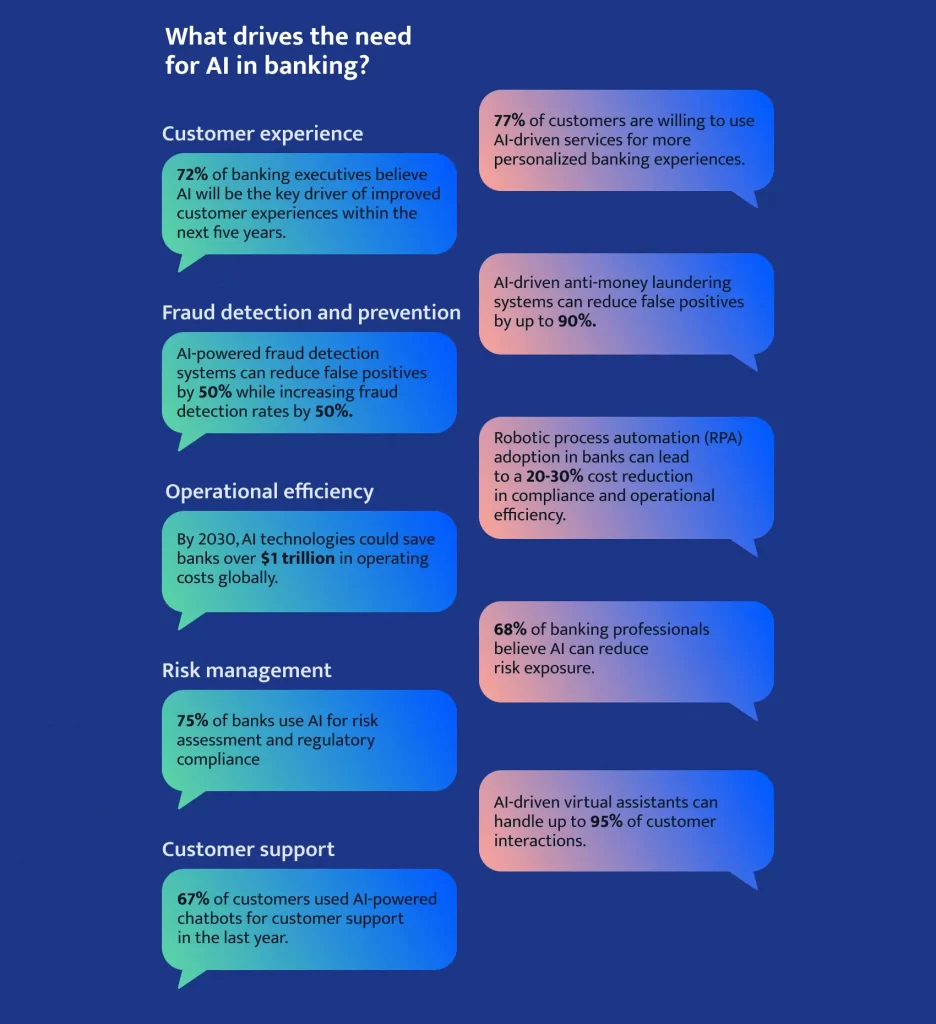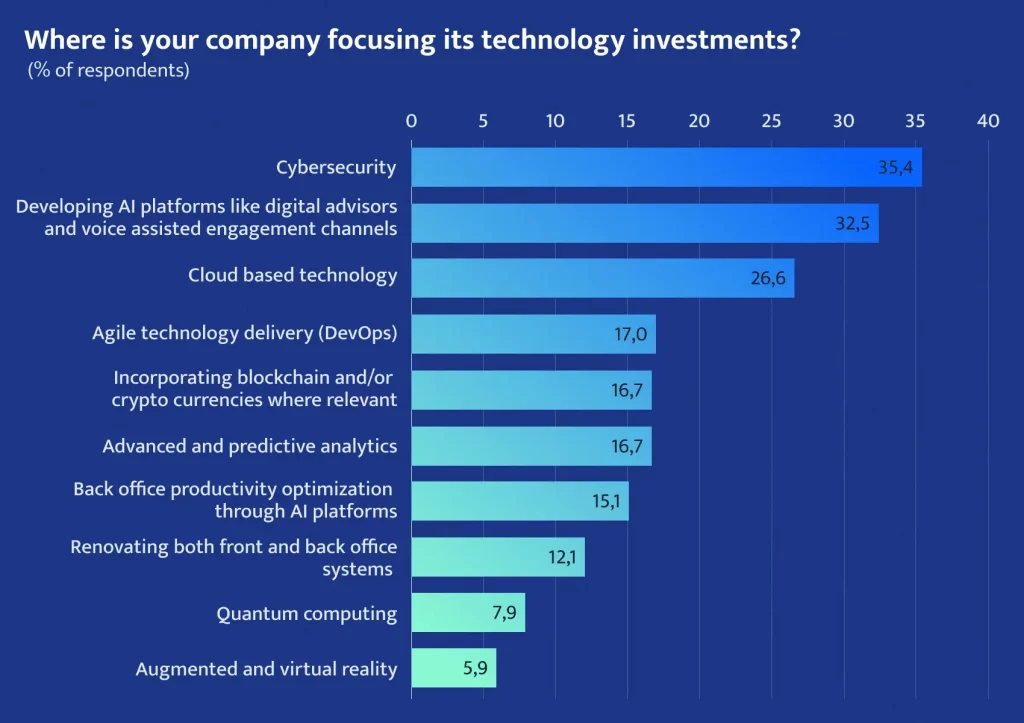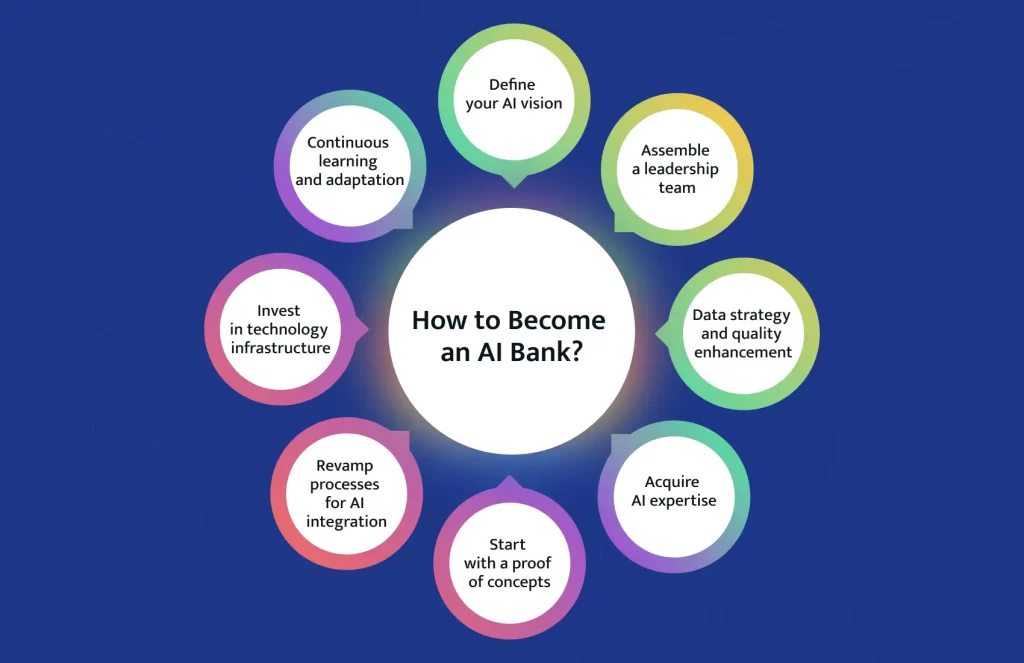AI-Powered Banking: Transformative Trends, Insights and Use Cases

As you enter into the complex world of AI in banking, you’re likely facing a crossroad of issues. The difficulties are significant – dealing with strict regulations, protecting data, and understanding the intricacies of AI implementation. The pivotal question arises: How can you harness the immense potential of AI in the banking industry while overcoming these hurdles?
This is where our shared journey begins. This article delves into the deep connection between AI and banking, shedding light on its role, impact, and transformative potential.
Our insights are not just theoretical – they’re etched from the crucible of practical experience.
Table of contents
- The AI Revolution: Why Ignoring AI Isn’t an Option
- Becoming an AI Bank: Strategies for Implementing Artificial Intelligence into Banking Operations
- Applications of AI in Banking and Finance: A Closer Look at Game-Changing Use Cases
- Challenges of Integrating AI in Finance and Banking
- Alternative-spaces Experience
- Closing Thoughts on AI’s Impact on Banking Industry
- FAQ
The AI Revolution: Why Ignoring AI Isn’t an Option
The financial landscape is undergoing profound transformation, and the banking sector is at the forefront of this revolution. As traditional models adapt to meet the demands of the digital age, Artificial Intelligence emerges as a potentially compelling solution that promises to reshape the way banks operate and serve their customers.

Here are key reasons why the adoption of AI in banking is no longer a luxury but a strategic imperative:
AI elevates customer experiences to new heights
AI-powered chatbots and virtual assistants can offer instantaneous and round-the-clock support, addressing customer queries and concerns quickly and accurately. These systems learn from customer interactions over time, allowing them to provide increasingly tailored and relevant assistance.
According to a study by Juniper Research, AI-driven chatbots are expected to help banks save over $7.3 billion in customer service costs globally by 2023.
Through predictive analytics, AI can analyze customer behavior and preferences to anticipate their needs, enabling banks to offer customized financial solutions and recommendations proactively.
The use of AI in banking expedites routine processes and empowers customers with data-driven insights, transforming how they manage their finances and interact with their financial institutions.
Personalized banking experiences
AI introduces a new level of personalization by leveraging advanced algorithms to analyze customer data and behaviors. This enables banks to offer tailored financial solutions, product recommendations, and services that align with individual preferences and needs. From personalized investment strategies to custom credit offerings, AI ensures that each customer’s unique financial journey is recognized and catered to, leading to a more engaging and customer-centric banking experience.
Accurate credit evaluation
By analyzing a wide array of data beyond traditional credit scores, AI algorithms assess an individual’s financial behavior, transaction history, and other relevant factors. This comprehensive evaluation results in more accurate and fair credit assessments, enabling banks to offer personalized lending solutions tailored to each customer’s unique financial profile.
Transformative data analytics capabilities
A study by Deloitte shows that 67% of financial institutions believe AI-driven predictive analytics will save them more than $1 million annually. By processing vast amounts of financial data, AI algorithms identify patterns, trends, and insights that were previously inaccessible. This enables banks to make informed decisions, develop innovative products, and tailor services to customer preferences. Moreover, AI-driven analytics enhance risk management, fraud detection, and compliance by identifying real-time anomalies and deviations. This data-driven approach empowers banks to stay competitive, offer better customer experiences, and adapt to dynamic market conditions with agility.
Fraud detection and cybersecurity
Based on a recent global banking survey conducted by The Economist Intelligence Unit, a significant portion of respondents from both commercial and private banks (35%) view technology investment as closely tied to cybersecurity. This highlights the prevailing apprehensions surrounding data breaches and security issues.

Source: The Economist Intelligence Unit
AI can analyze large datasets for unusual patterns and anomalies, enhancing security. Juniper Research predicts the global business spend on AI-enabled financial fraud detection and prevention strategy platforms will exceed $10 billion globally in 2027, rising from just over $6.5 billion in 2022.
AI-driven systems can continuously learn from data, adapting to evolving threats and preventing potential attacks. Through biometric authentication and behavioral analysis, AI ensures secure account access and detects unauthorized activities.
These statistics demonstrate the compelling benefits of AI in the banking industry to stay competitive, improve efficiency, and deliver enhanced customer experiences. As AI continues to advance, its integration into the banking sector is poised to drive significant transformations and innovations.
Becoming an AI Bank: Strategies for Implementing Artificial Intelligence into Banking Operations
Becoming an AI-driven bank involves a strategic approach that integrates artificial intelligence across various aspects of banking operations. Here’s a step-by-step guide to adopting Artificial Intelligence in the banking industry:

Define your AI vision:
Embark on your AI transformation journey by setting a clear vision. Understand how AI can reshape customer experiences, operational efficiency, and decision-making within the banking sector. Establishing a compelling AI vision provides a strategic direction for your bank’s transformation.
- Define your bank’s vision and objectives for AI integration.
- Identify areas where AI can add value, such as customer service, fraud prevention, or data analytics.
- Develop a comprehensive AI strategy aligned with your bank’s goals.
Assemble a leadership team
Building a dedicated team of AI leaders who deeply understand banking and AI is crucial. These leaders will drive AI initiatives, aligning them with the bank’s overarching goals and shaping a culture of innovation.
- Appoint leaders who understand AI’s potential and can guide its integration.
- Build cross-functional teams that combine banking expertise and AI knowledge to ensure a holistic approach.
Data strategy and quality enhancement
The foundation of AI is data. Data forms the bedrock of AI. Develop a comprehensive data strategy encompassing collection, storage, quality enhancement, and security. Investing in robust data practices ensures your AI initiatives are fueled by accurate, relevant, and ethically managed data.
- Establish robust data governance and management practices to ensure data accuracy, security, and compliance.
- Collect and curate high-quality data to fuel AI algorithms effectively.
Acquire AI expertise
To ensure the successful integration of AI in your banking operations, it’s crucial to collaborate with experienced AI professionals. Strengthen your team by hiring AI experts, data scientists, and machine learning specialists. With these specialists, you gain access to the necessary expertise to build and implement AI-driven solutions that enhance your bank’s efficiency, customer experience, and overall competitiveness in the financial industry.
- Hire skilled AI experts, data scientists, and machine learning engineers.
- Train existing staff to understand AI concepts and applications.
Start with a proof of concepts
As you embark on the journey to establish an AI-powered bank, consider starting with Proof of Concepts. These PoCs involve creating small-scale prototypes or experiments that showcase the feasibility and potential of AI within the banking context.
Read also: The Meaning and Methods of PoC in Software Development
As an experienced software development team, we can develop PoCs and demonstrate how AI can enhance your various banking processes, such as customer service, fraud detection, risk assessment, and more. These tangible examples help you visualize the benefits of integrating AI and build confidence in its capabilities. PoCs also provide valuable insights into technical challenges, allowing you to address any potential roadblocks early in development. This step ensures a solid foundation for scaling up your AI bank with a deep understanding of its potential impact and benefits.
- Start with smaller AI initiatives to test their feasibility and effectiveness.
Revamp processes for AI integration
Revamping your existing processes is essential to integrate AI into your banking operations seamlessly. This involves thoroughly reviewing and adapting your workflows to accommodate AI-powered solutions. Identify key areas within your banking processes where AI can make the most impact, such as customer service, risk assessment, fraud detection, and personalized financial recommendations.
Collaborate with your internal teams, including IT specialists, operations, and customer service, to understand their needs and challenges. Design new processes that effectively incorporate AI technologies, ensuring they align with your business goals and customer expectations.
- Review and adapt workflows for AI solutions
- Identify impactful AI integration areas (customer service, risk assessment, etc.)
- Design new processes with AI technologies
- Align new strategies with business goals and customer expectations
Invest in technology infrastructure
Your bank should have a robust and capable technology infrastructure to support AI initiatives effectively. This step ensures that your bank’s technology foundation is strong enough to accommodate the data processing, storage, and computational demands that AI applications entail.
The Alternative-spaces experts can assess your existing technological capabilities and ensure that they align with the requirements of AI implementation. We evaluate your hardware, software, network, and data storage capacities to determine if any upgrades or enhancements are necessary. If you need help, contact us.
Read also: Business Benefits of DevOps: What You Need To Know About It?
Continuous learning and adaptation
Stay updated with the latest advancements in AI technology and trends within the financial industry. Encourage your team to participate in training programs, workshops, and online courses focused on AI and its applications in banking.
Regularly assess the performance of your AI-powered solutions and gather feedback from both your customers and internal teams. Use this feedback to identify areas of improvement and make necessary adjustments to enhance the effectiveness of AI integration. Additionally, monitor the evolving regulatory landscape to ensure your AI implementations comply with industry standards and data privacy regulations.
By fostering a continuous learning and adaptation culture, your bank can stay at the forefront of AI innovations and leverage them to drive better customer experiences and business outcomes.
- Monitor the performance of AI systems, tracking accuracy and efficiency.
- Incorporate feedback and new data to retrain models and algorithms for ongoing improvement.
Applications of AI in Banking and Finance: A Closer Look at Game-Changing Use Cases
AI has ushered in a new era of innovation in the banking and finance sector, offering many applications that enhance operations, customer experiences, and decision-making processes. Here are some of the prominent AI use cases in banking:
Customer service and support with chatbots
One of the most prominent use cases of AI in the banking industry is the integration of chatbots for customer service and support. These virtual assistants handle routine inquiries, process transactions, and offer personalized recommendations, improving customer engagement and satisfaction.
For example, Bank of America introduced “Erica,” an AI-powered virtual financial assistant. Erica helps customers manage their finances, providing insights on spending habits, bill reminders, and more. Customers can communicate with Erica through both text and voice commands, making it a versatile and user-friendly solution.
What you get with AI-powered chatbots:
- 24/7 availability for customers, improving overall customer experience.
- Instant responses and resolution of queries, reducing wait times.
- Consistency in providing accurate information.
- Cost savings for banks by reducing the need for extensive human customer support.
- Ability to handle multiple inquiries simultaneously, ensuring efficient customer interactions.
Read also: How to start a neobank
Personalized financial advice and recommendations
AI technology revolutionizes the banking industry by enabling personalized financial advice and customer recommendations. Through data analysis and machine learning algorithms, banks can offer tailored insights to help customers make informed financial decisions based on their individual goals and circumstances.
For example, My Chase Plan is an application of artificial intelligence in banking that helps Chase Bank credit cardholders create repayment plans for specific purchases. The AI-driven algorithm analyzes transaction data and allows users to pay off larger purchases over time with a fixed fee and interest rate.
Moreover, JPMorgan Chase is creating a software service akin to ChatGPT, which utilizes an innovative type of artificial intelligence to assist in choosing investments for its clientele, as reported by CNBC. The New York-based bank recently submitted a trademark application for a product named IndexGPT. According to the filing, IndexGPT will utilize “cloud computing software employing artificial intelligence” to meticulously analyze and choose securities that align with individual customer requirements.
What you get with an application of AI in providing personalized financial advice and recommendations:
- Customized financial guidance tailored to each customer’s unique circumstances.
- Improved decision-making based on data-driven insights.
- Enhanced financial literacy as customers gain insights into their spending habits and investment opportunities.
- Cost-effective solutions that eliminate the need for extensive human financial advisory services.
- Accessibility to personalized advice 24/7, allowing customers to make informed decisions at their convenience.
Fraud detection and prevention
AI has become a powerful tool in the banking sector for detecting and preventing fraudulent activities. Through advanced algorithms and machine learning, banks can identify patterns, anomalies, and suspicious behaviors in real time, helping to safeguard customer accounts and financial transactions.
For example, HSBC employs AI technology to enhance its AML efforts. The bank uses machine learning algorithms to analyze large volumes of transactions and detect unusual patterns that could indicate money laundering or other illicit activities.
What you get by implementing AI for fraud detection and prevention:
- Real-time monitoring and alerts enable swift responses to potential fraud.
- Detection of complex patterns and anomalies that human analysts might miss.
- Reduction of false positives, leading to improved customer experience.
- Continuous learning from new data, enhancing the accuracy of fraud detection over time.
- Enhanced security measures protect both customers and the bank from financial losses.
Credit scoring and loan approval
AI-driven credit scoring and loan approval systems are transforming the traditional lending process by making it more efficient, accurate, and inclusive. By analyzing a wide range of data points, AI algorithms assess the creditworthiness of applicants and provide lenders with insights to make informed decisions on loan approvals.
For example, Zest uses AI to evaluate broader data points beyond traditional credit bureau data. This approach allows lenders to provide loans to individuals who may not have a well-established credit history. ZestFinance’s algorithms assess thousands of variables to predict an applicant’s creditworthiness.
What you get with an AI-driven credit scoring and loan approval system:
- More accurate risk assessment based on a broader set of data.
- Faster loan approval processes, reducing waiting times for borrowers.
- Inclusion of underserved individuals who may not have traditional credit histories.
- Reduced bias and subjectivity in lending decisions.
- Enhanced efficiency and scalability in processing loan applications.
Algorithmic trading and investment strategies
AI-powered algorithms analyze vast amounts of market data in real time, identifying patterns, trends, and opportunities that human traders might miss. Algorithmic trading offers speed, accuracy, and the ability to execute complex strategies with minimal human intervention.
For example, BlackRock’s Aladdin platform utilizes AI to analyze market data, news, and economic indicators to make informed investment decisions. Aladdin’s algorithms assist in portfolio construction, risk management, and trading across various asset classes.
What you get with an algorithmic trading and investment solution powered by AI:
- Lightning-fast execution of trades in response to market changes.
- Ability to process and analyze vast amounts of data quickly.
- Reduced emotional bias in decision-making.
- Automation of repetitive tasks, allowing traders to focus on strategy.
- Potential for uncovering hidden patterns and opportunities in market data.
Customer behavior analysis for targeted marketing
Banks can gain insights into individual customer preferences, spending patterns, and engagement behaviors by leveraging AI algorithms. This information helps banks create personalized marketing campaigns and offers that resonate with customers, improving customer satisfaction and increased engagement.
For example, Wells Fargo uses AI-powered analytics to understand customer behavior and preferences. The bank analyzes transaction data, browsing history, and other interactions to tailor personalized product recommendations and targeted marketing messages to individual customers.
What you get using AI for customer behavior analysis in targeted marketing:
- Enhanced understanding of customer preferences and behavior.
- More personalized marketing messages and offers.
- Improved customer engagement and satisfaction.
- Higher conversion rates for marketing campaigns.
- Optimal allocation of marketing resources to high-potential segments.
- Reduction in marketing costs through precise targeting.
These applications of AI in banking represent just a fraction of this technology’s transformative capabilities. By embracing AI-driven solutions, banks can streamline operations, enhance customer experiences, mitigate risks, and make well-informed decisions in the ever-evolving banking and finance landscape.
Challenges of Integrating AI in Finance and Banking
The introduction of AI into critical sectors like finance and banking undoubtedly brings about transformative possibilities. However, it’s essential to acknowledge that this integration has its challenges. As AI gains ground in the realm of banking, several noteworthy challenges emerge that require careful consideration and strategic solutions:
Data privacy and security concerns
Implementing AI in the banking sector introduces significant data privacy and security challenges. As AI systems rely heavily on large volumes of sensitive customer data, ensuring this data’s confidentiality, integrity, and compliance becomes paramount. Banks are entrusted with safeguarding customer financial information, and any breaches or mishandling of data can lead to severe consequences, including regulatory penalties, reputational damage, and loss of customer trust.
How the Alternative-spaces team addresses data privacy and security concerns:
- Robust encryption. We implement end-to-end encryption to protect customer data during storage, transmission, and processing.
- Anonymization techniques. Our experts apply techniques like data anonymization and pseudonymization to ensure that individual customer identities are not easily traceable.
- Data minimization. We collect only the necessary data for AI algorithms, minimizing the risk of handling sensitive information.
- Ethical AI practices. Our specialists develop AI systems that undergo rigorous testing to identify and eliminate algorithmic bias, ensuring fair and equitable outcomes.
Regulatory compliance
One of the significant challenges in implementing AI in the banking sector is ensuring regulatory compliance. The banking industry is highly regulated with strict rules and guidelines that govern various aspects of operations, customer interactions, data handling, and financial transactions. Introducing AI systems requires navigating complex regulatory landscapes to ensure that AI solutions adhere to existing and emerging rules.
The Alternative-spaces team successfully navigates regulatory compliance challenges ensuring that AI-driven solutions in banking meet legal requirements, maintain customer trust, and prevent potential legal and financial repercussions. Our strategies include:
- Ethics and governance frameworks. We develop comprehensive ethical and governance frameworks for AI that ensure adherence to regulations, transparency, and accountability.
- Explainable AI. We create AI models that explain their decisions, enhancing transparency and compliance.
- Audit trails. Our specialists implement robust audit trails that track AI systems’ data and decision-making processes, facilitating transparency and accountability.
Unintentional bias
Implementing AI in banking introduces the bias challenge in decision-making processes. AI systems learn from historical data, and if that data contains biases, these biases can lead to unfair outcomes in lending, credit scoring, and other financial services. If the training data used for AI models is not diverse, the resulting models may not accurately represent all customer segments, leading to biased outcomes.
At Alternative-spaces, addressing bias challenges is crucial. To maintain customer trust, prevent discrimination, and comply with regulations, we provide some mitigation strategies:
- Diverse data. Our experts ensure training data is diverse, representative, and reflective of the entire customer base to reduce bias and improve fairness.
- Bias detection and correction. We regularly audit AI models to detect and correct bias and implement mechanisms to adjust model outcomes and ensure fairness.
- Explainable AI. We opt for explainable AI models, allowing for better identification and correction of biases in the decision-making process.
- Ethical guidelines. Our specialists establish ethical guidelines for AI development that include fair treatment of all customers, regardless of characteristics.
- Ongoing monitoring. The Alternative-spaces team continuously monitors AI systems for biased outcomes and makes necessary adjustments as data evolves.
Acknowledging these challenges of artificial intelligence in banking and proactively working to address them is essential for successfully integrating AI into the banking sector. By navigating these complexities, banks can unlock the full potential of AI while ensuring the safety, security, and integrity of financial operations.
Alternative-spaces Experience
Alternative-spaces has diversified experience in both fintech app development and the implementation of artificial intelligence. Through our extensive involvement in fintech app development, Alternative-spaces has honed its ability to conceptualize, design, and create cutting-edge solutions that cater to the evolving needs of the financial industry.
From customer experiences and risk management to fraud detection and personalized financial solutions, the Alternative-spaces team knows how to harness AI’s capabilities to elevate banking services to new heights.
Read How To Build Finance Management App: Alternative-spaces Success Story to gain an in-depth understanding of how our expertise contributed to crafting an investment management app, leading our client to conquer the market and attain outstanding achievements.
Our team of app development experts is equipped to create custom solutions that align with your specific objectives and requirements!

Closing Thoughts on AI’s Impact on Banking Industry
The marriage of cutting-edge technology with financial services has ushered in a new era of possibilities, offering enhanced customer experiences, refined operational efficiency, and data-driven decision-making. While challenges such as data security, regulatory compliance, and ethical considerations require diligent attention, the benefits of AI in banking are undeniable.
If you’re interested in implementing AI or have any questions, please contact our team. We are here to support you in transforming your vision into a successful and impactful application.
FAQ
- What is AI’s role in the banking sector?
AI in banking and finance encompasses enhancing customer experiences, improving risk management, enabling personalized financial services, automating processes, detecting fraud, optimizing investments, and ensuring regulatory compliance, among other functions. It revolutionizes how banks operate, interact with customers, and make strategic decisions.
- Can AI improve fraud detection and cybersecurity in banking?
Yes, AI can significantly improve fraud detection and cybersecurity in banking. AI algorithms can analyze vast amounts of data in real-time to detect patterns and anomalies that might indicate fraudulent activities. Machine learning models can learn from historical data and identify new types of fraud as they emerge.
Additionally, using AI in the banking sector can enhance cybersecurity by monitoring network traffic, identifying potential threats, and responding to cyberattacks faster than human intervention. Advanced AI-powered authentication methods, like biometrics, can also enhance security measures.
- How can Alternative-spaces help with implementing AI in my bank?
Alternative-spaces empowers your bank’s AI implementation through strategic consultation, customized solutions, data management, AI model development, ethical integration, training, continuous monitoring, regulatory compliance, and measurable results. Our expertise ensures a seamless AI journey that enhances operations, customer experiences, and decision-making.
- What are the top AI trends in banking?
The top AI trends in banking include hyper-personalization for customers, advanced chatbots and virtual assistants, enhanced fraud detection and prevention, AI-driven customer insights and analytics, compliance automation, algorithmic trading, credit scoring, voice and biometric recognition, robotic process automation (RPA), and AI in regulatory reporting. These trends reflect the industry’s focus on leveraging AI to improve customer experiences, streamline operations, enhance security, and ensure regulatory compliance.
- How is AI in banking aligned with regulatory standards?
Artificial intelligence in banking is aligned with regulatory standards by implementing robust data privacy and security measures. Banks should ensure that AI systems comply with regulations such as GDPR, HIPAA, and industry-specific standards. Transparent algorithms, explainable AI, and ethical AI practices are adopted to prevent biases and unfair practices. Regular audits, risk assessments, and monitoring ensure that AI applications adhere to financial regulatory bodies’ legal and ethical frameworks.
Content created by our partner, Onix-systems.
Source: https://onix-systems.com/blog/artificial-intelligence-in-banking Home
Home